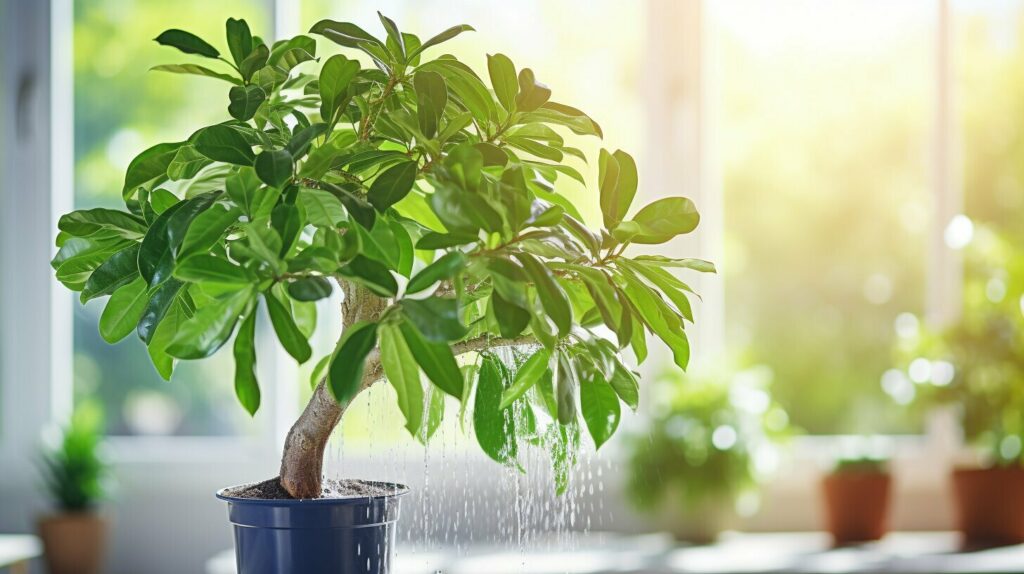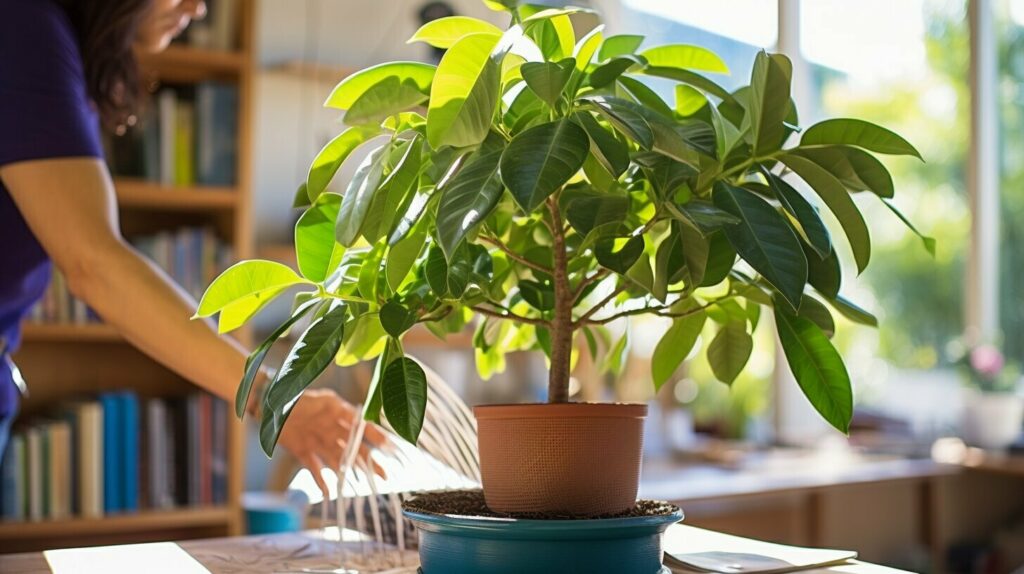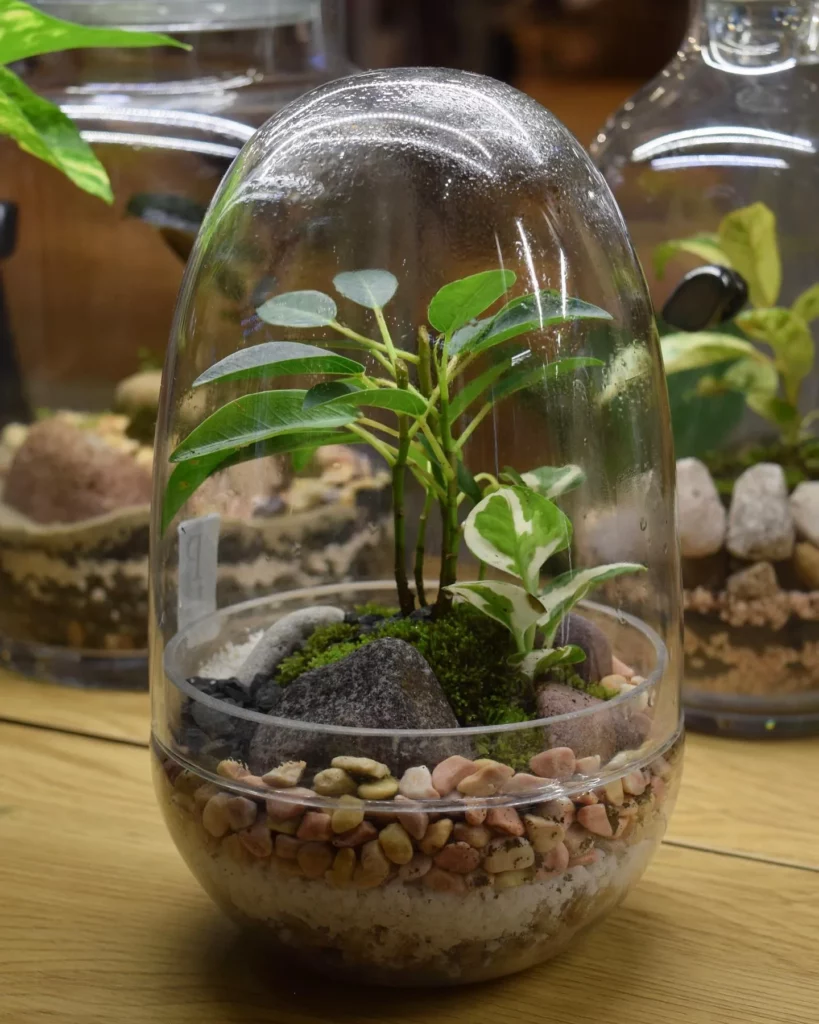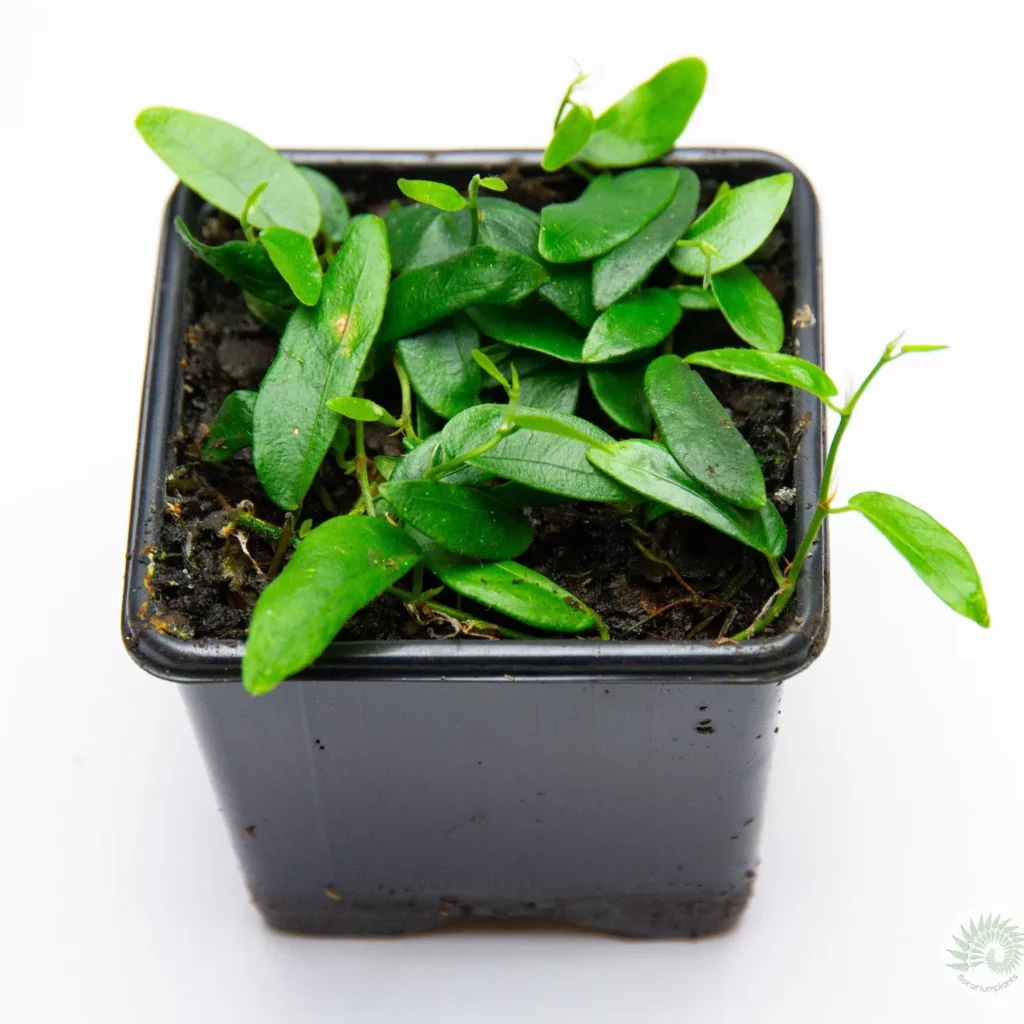The ficus retusa, originating from Southeast Asia and India, is a favored indoor bonsai tree worldwide. It attracts with its shiny leaves and interesting aerial roots. This guide explores how to care for the ficus retusa, ensuring its beauty thrives indoors.
Key Takeaways
- Ficus retusa is a tropical houseplant native to Southeast Asia, ideal for indoor bonsai cultivation.
- This species boasts glossy leaves, fascinating aerial roots, and remarkable resilience.
- Proper lighting, watering, pruning, and pest management are essential for healthy growth.
- Ficus retusa tolerates low light but thrives in bright, sunny locations.
- Regular fertilization, repotting, and defoliation techniques promote abundant branching and compact foliage.
Introduction to Ficus Retusa
The ficus retusa is a member of the Ficus family, which has over 800 species. It has a long history in the art of bonsai that goes back more than a thousand years. This tree is important in Chinese and Indian medicine. People believe it has healing powers. It is also a symbol of coming together and luck in many parts of the world.
History and Background
The ficus retusa, also known as the Ficus microcarpa Retusa, is loved by bonsai fans. It has a story that dates back thousands of years. People in China and Japan admire it for being beautiful in a small form. It keeps its twisted, elegant shape when grown as bonsai.
Varieties of Ficus Retusa
There are many bonsai-friendly ficus types, each with special traits:
- Ficus microcarpa: A small type with shiny leaves, perfect for bonsai.
- Willow leaf ficus: It has willow-like leaves and is very graceful.
- Ficus ginseng: Recognized for its thick trunk that looks like a ginseng root. Sometimes, it is mixed with microcarpa leaves.
- Other varieties include tigerbark, golden gate, religiosa, benjamina, and taiwan ficus.

Every ficus variety has something special. From the tiny microcarpa to the graceful willow leaf ficus, there’s something for everyone. The ficus retusa’s history and cultural importance make it a favorite for bonsai. It’s loved by people around the world, both for inside and outside growing.
Selecting the Right Container and Soil
Choosing the correct bonsai pots and bonsai soil mix is super important for a ficus retusa bonsai. It’s key for their health and growth. Ensure the pot fits the tree’s roots and has good drainage. This stops the roots from getting too wet. Don’t pick a pot that’s too big for the bonsai.
The best bonsai soil mix for a ficus retusa is well-draining and lightly acidic. Mix equal parts of peat moss, sand, and perlite. This mix helps the roots grow strong and the tree to thrive.
- The pot’s height should match the trunk’s width above the surface roots (Nebari).
- Oval and rectangular pots should be 2/3 of the tree’s height, while round or square pots should be 1/3 of the tree’s height.
- Choose a pot material that complements the tree’s aesthetic, such as ceramic or porcelain. They absorb water and are great for the bonsai’s health.
- The pot’s color and glaze should harmonize with the tree’s bark, leaves, fruit, or flowers.
By picking the right container and soil, your ficus retusa bonsai will do well. It will show off its natural beauty.
Lighting Requirements

The right lighting is key for your Ficus retusa bonsai‘s health and growth. These trees from warm climates love bright, indirect light. But, they don’t like direct sunlight because it can hurt their leaves. Here are some placement tips to meet their needs:
Indoor Placement
Indoors, place your Ficus retusa by a well-lit window needing lots of sunlight. Windows facing east or west are best. They give the tree the bright, indirect light it needs. Just don’t let it get too much direct sunlight, or the leaves might get scorched.
- Use sheer curtains or blinds to filter intense sunlight
- Rotate the tree regularly to ensure even light exposure
- Supplement with grow lights if natural light is insufficient
Outdoor Placement
Your Ficus retusa bonsai shines outside with its preferred bright, indirect light. But, it needs some shade to shield it from too much sun. Especially when the sun’s hottest, a little shade is good.
If it gets cold where you live, move your Ficus retusa inside before it freezes. It can’t handle temperatures under 60°F (15°C). Expect to water it more when it’s outside. The extra sun and wind make the soil dry out quicker.
Getting the light just right means healthy leaves and strong growth for your Ficus retusa bonsai. Watch how your tree reacts to light and make changes as needed. This keeps your tree happy and growing well.
Watering and Humidity Needs

It’s key to know how much water and humidity your Ficus retusa needs. These plants are tough and handle little water well. Yet, they need steady watering to keep their leaves lush and bright.
Signs of Overwatering and Underwatering
Too much water can lead to root rot. This happens with soggy soil and bad drainage. You’ll notice wilting leaves and yellowing, showing your plant isn’t happy. Let the soil dry a bit between waterings to avoid this issue.
But, don’t forget to water enough. If the leaves start to wilt and feel dry, you’ve waited too long to water. It’s all about finding the right balance.
Misting and Humidity Levels
Ficus retusa can survive in drier places due to their waxy leaves. Still, they do best with lots of humidity. This helps them grow aerial roots, a cool feature of these plants.
Again, not too much misting. Too wet and you’ll get fungal issues. For really good aerial roots, think about sealing in some moisture. A glass top or fish tank terrarium make good options.
- Water your Ficus retusa when the top inch of soil feels dry, allowing excess moisture to drain away.
- Monitor for signs of overwatering, such as wilting, yellowing leaves, and soggy soil, which can lead to root rot.
- Underwatering is evident through wilting and dry, brittle leaves, so maintain consistent soil moisture without overwatering.
- While tolerant of lower humidity, Ficus retusa prefers high humidity to develop aerial roots.
- Regular misting can increase humidity, but excessive misting can encourage fungal growth.
- An enclosed, humid environment like a glass cover or fish tank terrarium may be necessary for optimal aerial root growth.
Ficus Retusa Care Guide
Creating a happy Ficus retusa bonsai needs special care and the right home. This guide will teach you everything about Ficus bonsai care. This will help your small tree grow well indoors.
Fertilizing Schedule
Regular feeding is important for your Ficus retusa to grow strong and beautiful. In spring, summer, and autumn, feed it with a balanced fertilizer every two weeks. During winter, trim feeding down to every month. You should use fertilizer as the label tells you to.
Repotting and Root Pruning
Keep your Ficus retusa healthy by repotting every few years. This step prevents its roots from crowding. When repotting, untangle and trim any long roots. This plant does not mind having its roots trimmed. Use fresh, good-draining bonsai soil when replacing the tree in a pot.
- Keep up with regular feeding using a balanced fertilizer with lots of nitrogen in the growing season.
- Repot and trim roots every 2-3 years in the spring. Use new bonsai soil when you do this.
By sticking to these steps for feeding, repotting, and pruning, your Ficus retusa bonsai will thrive. It will grow strong and look amazing.
Pruning and Wiring Techniques
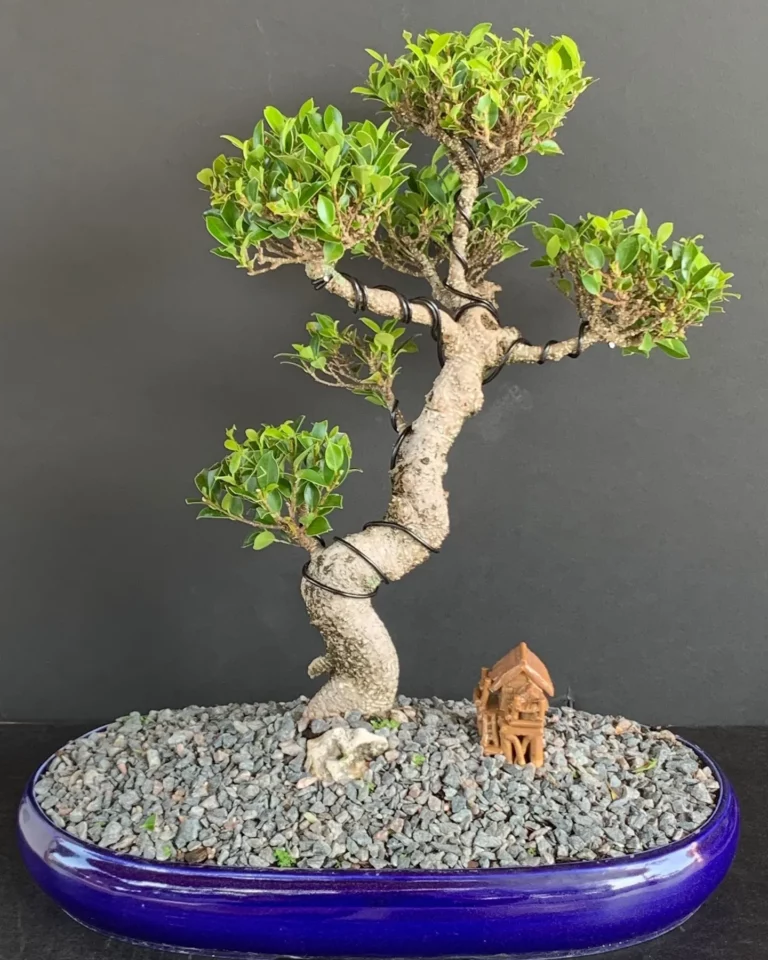
Pruning and wiring help give shape and keep your bonsai looking great. They make your Ficus retusa grow better, with smaller leaves. This makes your little tree look even more beautiful.
Leaf Pruning and Defoliation
Leaf pruning, or taking off some leaves, makes your Ficus retusa grow more branches and small leaves. It makes the tree think it’s time to rest. So, the new leaves that grow are tiny. Do this in early summer, after the first growth in spring.
- Only trim the leaves of strong, healthy trees.
- Don’t cut off more than 25% of the leaves at once.
- Always use sharp bonsai shears or snips.
Wiring for Shaping
Ficus retusa’s branches are flexible, which is great for wiring them into shape. After cutting, you can bend the branches where you want them. You might need to use special wires for thicker branches to not break them.
Here are some tips for wiring:
- Check the wires often to prevent them from digging into the tree.
- Strong, high-carbon steel wires are best because they last longer.
- Prune and wire when the tree isn’t actively growing to keep it healthy.
It’s also important to regularly clean and sharpen your bonsai tools. This will make sure your trees don’t get hurt when you work on them.
By learning these pruning and wiring methods, you can make a beautiful Ficus retusa bonsai. It will be a perfect, tiny tree that shows off your creative style.
Propagation Methods
The Ficus retusa is amazing because it can grow in many ways. You can increase your bonsai collection or make a unique one. Learning how to do this opens up many options for you.
Air Layering
The air layering technique is great for the Ficus retusa. It’s best done in spring, April and May, when the tree grows the most. This method focuses on growing roots on a branch first, then you can cut it and plant it on its own.
- Start by making a shallow cut around a branch, penetrating the bark and exposing the cambium layer.
- Apply a rooting hormone to the exposed area to stimulate root growth.
- Wrap the area with a moisture-retaining medium, such as sphagnum moss, and secure it with plastic or aluminum foil.
- Monitor the progress regularly and, after several weeks, roots should begin to emerge within the wrapped area.
- Once the roots have developed sufficiently, carefully separate the layered portion from the parent plant and transplant it into its own container.
Cuttings and Grafting
Another way to grow Ficus retusa is from stem cuttings. Doing this in the middle of summer gives you more chances of success. Take a healthy branch, remove the bottom leaves, put it in rooting hormone, and plant in soil that drains well.
If you’re into creative bonsai, you might like grafting. A technique like approach grafting lets you mix different types of Ficus retusa. You can blend branches or roots to create bonsai plants that are one-of-a-kind, showing off cool leaf patterns, barks, and styles.
Finding your favorite way to grow Ficus retusa bonsai is a fun path to take. It lets you add more plants to your collection while enjoying the art of growing bonsai.
Pests and Diseases
To keep your ficus retusa healthy, start with the right environment. This means making sure there’s enough humidity and air circulation. If you don’t, your plant can get weak and sick easily. It’s important to be on the lookout for problems and deal with them right away to keep your plant growing strong.
Common Pests and Their Treatment
Here are some pests that might bother your ficus retusa:
- Spider mites are tiny and can make webs. They make leaves change color. Use a special bug killer (acaricide or miticide) to get rid of them.
- Thrips are small bugs that make white marks on leaves as they move. If you see this, take off the bad leaves and use a systemic insecticide.
- Mealybugs look like bits of cotton and go on the stems and leaves. You can use a special soap or spray to kill them.
- Scale insects are hard and stick on plants. They make plants yellow and can eventually kill them if you don’t stop them.
Finding these pests early and treating them quickly is very important to keep your plant healthy.
Disease Prevention and Management
Making sure your plant is in the right conditions is key. It not only helps it grow well but also stops it from getting sick. Here are some diseases your ficus might get:
| Disease | Cause |
|---|---|
| Anthracnose | Glomerella fungus |
| Bacterial leaf spot | Xanthomonas campestris bacteria |
| Branch dieback | Phomopsis fungus |
| Cold injury | Sudden temperatures below 10°C (50°F) |
| Foliar nematodes | Aphelenchoides parasites |
To keep these diseases away, make sure there’s enough humidity and air circulation. Don’t let the plant get too cold or too dark. Fixing things that make the plant weak can also keep diseases at bay.
Being watchful and doing things to prevent issues will help your ficus bonsai live a long, healthy life.
Purchasing and Selecting a Ficus Retusa Bonsai
Choosing a ficus retusa bonsai is important and needs a keen eye. Many are not built with strong foundations. They may have marks from wires, poor grafting, and use the wrong pots or soil. It’s better to buy from specialists or dedicated bonsai shops than regular garden centers.
Here are some main things to look for in a ficus retusa bonsai:
- Check it carefully for damage, sickness, or bugs.
- Want one that’s symmetrical, with a sturdy trunk and branches.
- Find a tree with strong roots, not cramped in its pot.
- Make sure the soil lets water pass through and is good for bonsai.
- Think about the tree’s age and how big or small you want it to be.
Finding a good ficus retusa bonsai can make caring for it easier later. A top-quality tree from an expert seller or specialist brings joy now and later. They can help you choose wisely and teach you how to take care of it well.
Remember, turning a basic bonsai into a masterpiece takes time. Letting it grow freely for a year or two before shaping starts the process. With careful pruning, you can create a stunning, balanced pre-bonsai ready for detailed work.
Conclusion
The Ficus Retusa is a great choice for bonsai lovers. Its unique roots and tropical look make it stand out. It’s great for both beginners and experts in bonsai. This is because it’s easy to take care of. You can keep it indoors all year and it will still look beautiful. Growing and shaping a Ficus Retusa bonsai is a fun and rewarding pastime.
It doesn’t matter if you’re new to bonsai or have been doing it for years. The Ficus Retusa is perfect because it doesn’t need a lot of maintenance. It can handle different indoor conditions well. With the right care, your Ficus Retusa bonsai will be a stunning view in your home. It will be something that brings happiness and calm for a long time.


